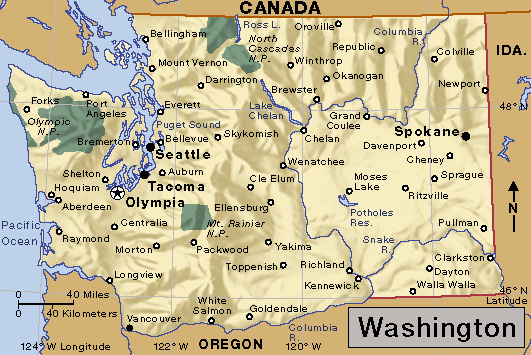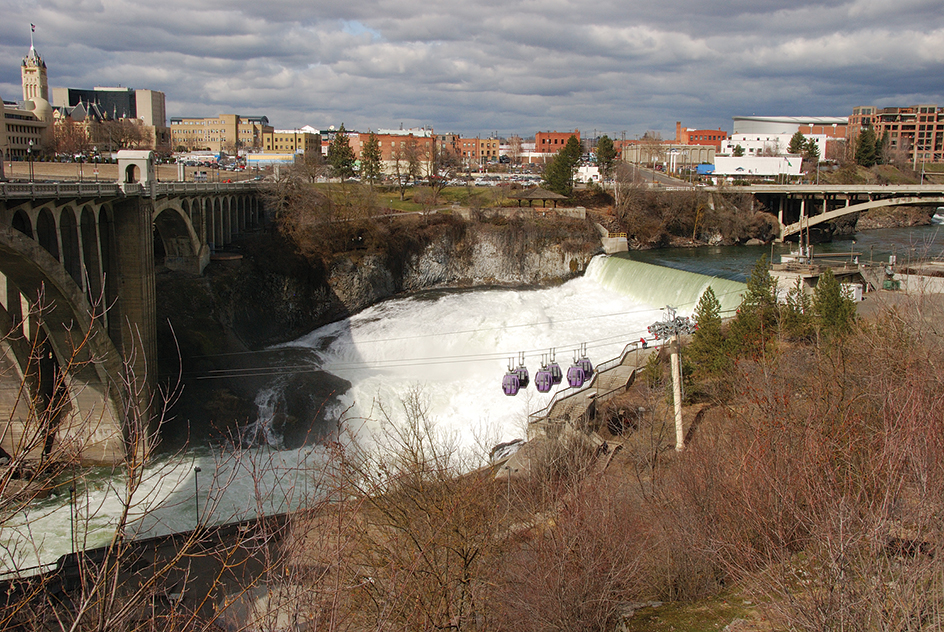Spokane, << spoh KAN >> (pop. 228,989; met. area pop. 585,774) is an important commercial center in eastern Washington. It ranks second to Seattle among the state’s largest cities. Spokane is the transportation center of the Inland Northwest. This rich agricultural, lumber, and mining area covers part of eastern Washington, northern Idaho, western Montana, and northeastern Oregon. Spokane, the seat of Spokane County, lies on the Spokane River, about 15 miles (24 kilometers) west of the Idaho border.

In 1810, the Canadian North West Company established a fur trading post called Spokane House near what is now Spokane. Permanent settlers came to the area in 1871. They were attracted by the falls of the Spokane River as a possible source of water power. They named their settlement Spokane Falls. The word Spokane is the name of an Indian tribe that lived in the area.
Description.
Two waterfalls in the center of the city furnish hydroelectric power and add to Spokane’s beauty. Riverfront Park, located at the falls, provides open space and recreational facilities. Other attractions include the Campbell House and the Northwest Museum of Arts and Culture, which houses one of the world’s largest collections of materials of the Plateau Indian group. Spokane has a symphony orchestra. Educational institutions in the city include Gonzaga University, Whitworth University, and a campus of Washington State University.

Economy.
Service industries such as wholesale and retail trade employ many Spokane workers. The city has hundreds of manufacturing firms. Their products include aircraft parts, computer equipment, fabricated metal machinery, food products, lumber and wood products, and primary metals.
Spokane International Airport lies southwest of the city. Passenger and freight trains also serve Spokane.
Government and history.
A mayor and a seven-member city council govern Spokane. Voters elect the mayor and a council president in a citywide election. Voters also elect two council members from each of the city’s three districts.
Spokane Indians lived in what is now the Spokane area when white people first arrived there in the early 1800’s. Spokane Falls was founded in 1871. A railroad first reached the community in 1881, and Spokane Falls also received a city charter that year. The discovery of silver and other minerals in the area attracted new settlers and businesses. A fire destroyed the city’s business district in 1889, but the people rebuilt their community. They renamed it Spokane in 1891.
During the late 1890’s, Spokane grew as a railroad center. New silver and lead mines opened nearby in northern Idaho during the early 1900’s and increased Spokane’s importance as a mining community. Immigrants from Europe helped boost the city’s population from 36,848 in 1900 to 104,402 in 1910. During World War II (1939-1945), Spokane served as a base for training pilots and as a center of aluminum production. The city’s population reached 181,608 in 1960, but many people moved to the suburban areas in the 1960’s and 1970’s.
In 1974, Spokane held a world’s fair called Expo ’74. In preparation for the fair, many redevelopment projects were carried out along the banks of the Spokane River. Riverfront Park was one such project. Several structures built for the fair became permanent features of the city, including a performing arts center and a convention center.
A major new shopping mall was completed near Riverfront Park in 2001. The mall, River Park Square, brought new growth to the area.
